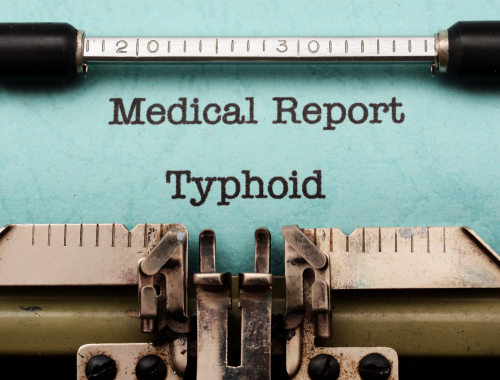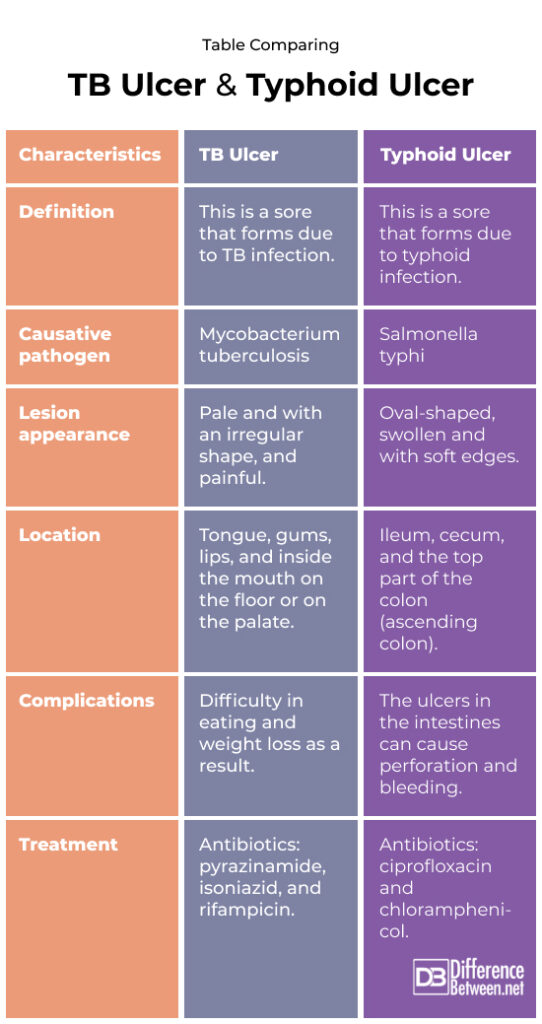Difference Between TB Ulcer and Typhoid Ulcer
A TB ulcer is a sore that forms as a result of a tuberculosis infection. A typhoid ulcer is a sore that forms in the intestines as a result of being infected with typhoid bacteria.

What is TB Ulcer?
Definition:
A TB ulcer is a lesion that develops usually around or in the mouth as a result of a tuberculosis infection.
Causes and prevalence:
Tuberculosis (TB) is an infectious disease caused by the organism, Mycobacterium tuberculosis. TB is a disease that mainly affects the lungs but can also impact other regions of the body including the spine, kidneys, and brain. Tuberculosis ulcers develop from the tubercles of the illness and are more common in sick patients who also smoke. Oral TB with lesions in the mouth is quite uncommon.
Symptoms and complications:
The ulcers of TB can be painful and occur most often in the mouth on the tongue, tonsils, salivary glands, gums, and palate. The ulcer is often an irregular shape and surrounded by reddened areas. Since ulcers may be painful, they can make a person not want to eat. This, in turn, can lead to weight loss.
Diagnosis:
Diagnosis of a TB ulcer can be made by taking a sample of tissue (biopsy) from the ulcer and examining this under the microscope. An acid-fast stain called a Ziehl-Neelsen stain is done on a thin section of the tissue. The bacillus of the organism appears bright red when stained in this way. This then confirms the diagnosis as a TB ulcer. The patient is also likely to have many of the other symptoms of TB.
Treatment:
Treating TB ulcers requires the use of antibiotics, namely, the following: pyrazinamide, isoniazid, and rifampicin. Treatment often takes at least 6 months to be effective and should not stop until the patient is told to stop because there is a risk of antibiotic resistance developing.

What is Typhoid Ulcer?
Definition:
A typhoid ulcer is a lesion that develops in parts of the small intestine and ascending colon as a result of a typhoid infection.
Causes and prevalence:
Typhoid ulcers are caused by Salmonella typhi, the bacterium that causes typhoid fever. It is difficult to know how many cases there are of typhoid ulcers, but typhoid fever is relatively common worldwide with up to 21 million affected.
Symptoms and complications:
Typhoid ulcers are oval, with soft edges that are irregularly shaped. Typhoid can cause abdominal pain and fever. A dangerous complication of typhoid ulcers is intestinal perforation and massive bleeding, which can result in shock and even death.
Diagnosis:
The diagnosis of typhoid ulcers is achieved by endoscopy or colonoscopy. The endoscopy examines the top part of the digestive system while the coloscopy focuses on the colon. Both procedures use a camera to view the inside of the gastrointestinal wall, which can show the presence of ulcers.
Treatment:
Typhoid ulcers and typhoid, in general, are treated with antibiotics. The usual antibiotics used include ciprofloxacin and chloramphenicol. If ulcers cause perforation or bleeding then surgical intervention may become necessary. Sometimes bleeding ulcers can be clipped off during an endoscopy or colonoscopy.
Difference between TB Ulcer and Typhoid Ulcer?
Definition
A TB ulcer is a sore that is formed from a TB infection. A typhoid ulcer is a sore that is formed from a typhoid infection.
Causative pathogen
The pathogen that causes TB ulcers is Mycobacterium tuberculosis. The pathogen that causes typhoid ulcers is Salmonella typhi.
Lesion appearance
A TB lesion has an irregular shape, is pale in color, and is often painful. A typhoid lesion is oval-shaped, swollen, and with soft edges.
Location
TB ulcers occur most often in the mouth, on the lips, tongue, gums, and palate. Typhoid ulcers occur in the cecum, ileum, and ascending colon.
Complications
TB ulcers can make eating painful, which can result in weight loss. Typhoid ulcers can lead to intestinal perforation and bleeding.
Treatment
Antibiotics used to treat a TB ulcer include pyrazinamide, isoniazide, and rifampicin. Antibiotics used to treat a typhoid ulcer include ciprofloxacin and chloramphenicol.
Table comparing TB Ulcer and Typhoid Ulcer

Summary of TB Ulcer Vs. Typhoid Ulcer
- Both TB ulcers and typhoid ulcers are lesions that form in the body.
- TB ulcers mostly form in the mouth area while typhoid ulcers form in the intestines.
- Both TB ulcers and typhoid ulcers are treated using antibiotics.
FAQ
Which ulcer is seen in typhoid?
A longitudinal, ovoid ulcer is seen in the intestines of typhoid patients.
What are the features of typhoid ulcers?
Typhoid ulcers are oval-shaped and have soft yet irregular edges.
What are the characteristics of tuberculous ulcer?
A tuberculous ulcer is usually painful and has irregular edges.
What are the symptoms of typhoid and tuberculosis?
Typhoid has symptoms like belly pain, sore head, fever, diarrhea, or constipation. Tuberculosis symptoms include fever, night sweats, coughing (especially coughing up blood), and weight loss.
What is typhoid called today?
Today typhoid is called typhoid or typhoid fever.
- Difference Between Rumination and Regurgitation - June 13, 2024
- Difference Between Pyelectasis and Hydronephrosis - June 4, 2024
- Difference Between Cellulitis and Erysipelas - June 1, 2024
Search DifferenceBetween.net :
Leave a Response
References :
[0]Aoun, N., G. El‐Hajj, and S. El Toum. "Oral ulcer: an uncommon site in primary tuberculosis." Australian dental journal 60.1 (2015): 119-122.
[1]Khan, M. N. "Oral manifestations of Tuberculosis: the role of the dentist: communique." South African Dental Journal 70.10 (2015): 434-435.
[2]Sonavane, Amey D., et al. "Typhoid ulcer related massive gastrointestinal bleeding successfully treated with endoscopic therapy." The Egyptian Journal of Internal Medicine 32 (2020): 1-4.
